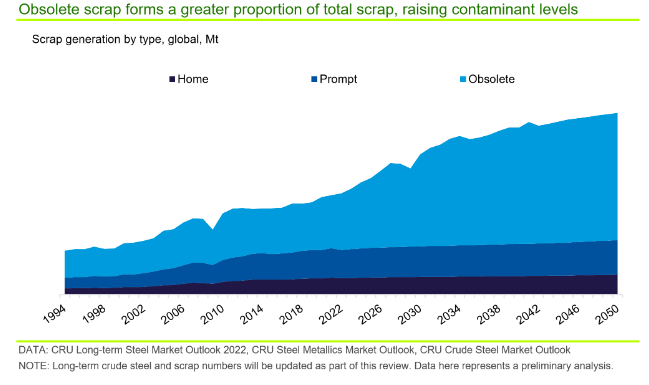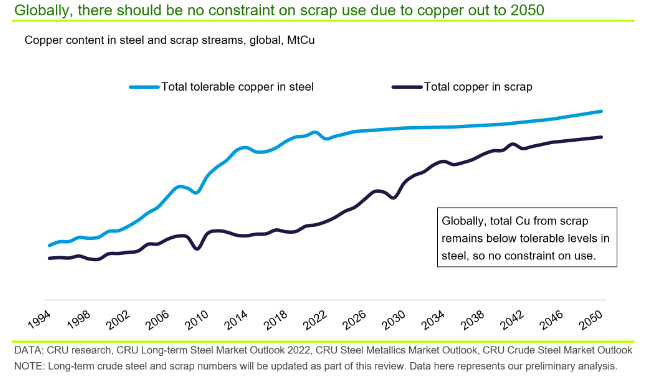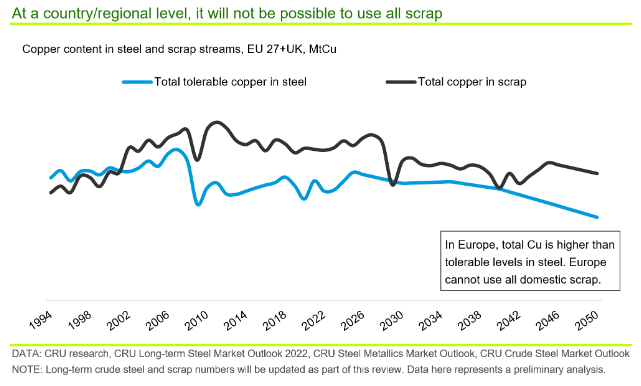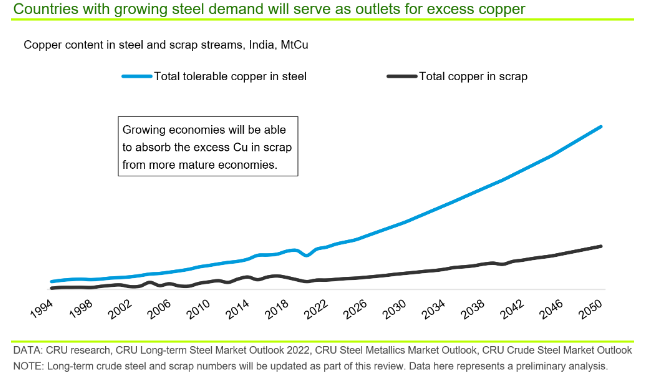Scrap Prices North America

CRU: Copper in Steel Scrap Will Constrain Domestic Use
Written by Thais Terzian
May 19, 2023
In the race to lower emissions, both steel companies and countries are promoting greater use of domestic scrap, but this approach has two key weaknesses. Firstly, using more steel scrap in one country will have no impact on global carbon emissions – it will simply see scrap use move from one country to another. Secondly, while at the global level there should be no constraint on scrap use due to higher levels of contaminants, at the country level this is far from the case. This analysis will feed into our view of scrap use and trade in CRU’s Long Term Steel Market Outlook, due in August.
![]() In this Insight we demonstrate why many countries will not be able to use all of their domestic scrap without significant costly processing, and that trade in scrap will be vital to ensure steel scrap can make a full contribution to the decarbonization of the steel sector.
In this Insight we demonstrate why many countries will not be able to use all of their domestic scrap without significant costly processing, and that trade in scrap will be vital to ensure steel scrap can make a full contribution to the decarbonization of the steel sector.
Steel Scrap Will be Fully Recycled Regardless of Decarbonization Trends
Steel scrap is the most recycled material in the world, it is already almost fully recycled and will continue to be so – primarily because it is economic and relatively easy to do so. Decarbonization will have no effect on this dynamic and specifying scrap-based steel will do little to further the trajectory of global decarbonization.
Having said that, scrap will make a key contribution to the decarbonization of the steel industry as more becomes available. However, as more scrap is generated – related to historical steel consumption – and it starts to account for a greater proportion of steel production, there are concerns that deteriorating quality could inhibit its full utilization, reducing its potential contribution to decarbonization.
There are several contaminants in scrap that can constrain its use. A key one is copper (Cu), which cannot be removed in the steelmaking process and can have deleterious effects on steel properties. Copper in scrap is typically derived from motor windings and cable that become entrained in the scrap stream and is a particular problem in end-of-life, or obsolete, scrap sources. Out to 2050, the proportion of obsolete scrap in total scrap will increase, therefore, the quantity of copper in the scrap system will rise. However, it is unclear whether this will constrain the amount of scrap that can be used without further processing.

For CRU’s Long Term Steel Market Outlook, we have begun to explore the impact of greater scrap availability on copper levels across the ‘steel system’ to understand if copper thresholds in steel will be breached. This Insight sets out some preliminary output that is providing interesting perspectives on the scrap market.
Increasing quantities of obsolete scrap threatens the role of scrap in steel decarbonization
There are broadly three different types of scrap:
• Home scrap: generated by a steel mill during steel production and immediately recycled back into the process
• Prompt scrap: generated by users of steel – associated with yield losses during manufacturing and use – and also quickly recycled
• Obsolete scrap: generated when steel applications and products reach the end of their life, which could be anywhere between <one year for a beverage can or 40–50 years for major infrastructure or a building. A ‘weighted average lifetime’ suggests that obsolete scrap generation broadly correlates with steel consumption from ~20 years ago.
Home and prompt scrap are relatively free of contaminants, but even where there are contaminants, the levels are typically precisely known, which makes them easier to use and, therefore, valuable to the steelmaker. On the other hand, obsolete scrap can have both high and variable levels of contaminants depending on the source and sophistication of collecting and processing. This makes obsolete scrap, at best, more difficult and costly to manage in the steelmaking process or, at worst, results in out-of-specification products and rework.
Obsolete scrap currently accounts for >50% of total scrap supply and so has a significant influence on overall scrap quality, and our preliminary modelling suggests this proportion will rise to ~70% by 2050 as more end-of-life scrap is generated. As obsolete scrap begins to account for a greater proportion of total scrap – raising contaminant levels and quality variability – and as scrap accounts for a greater proportion of steel produced, the quality deterioration will become a greater issue.
Deteriorating Scrap Quality Should Not Inhibit Scrap Use
To investigate the impact of scrap quality we have focused on copper in scrap, one of the most important contaminants, and the chart below shows our modelling of the scrap and steel system out to 2050.
Given the quantity and type of steel expected to be produced out to 2050 (n.b. steel data from the 2022 edition of CRU’s Long Term Steel Market Outlook has been used here), there is a maximum level of copper that can be tolerated at the global level, shown by the blue line in the chart. This amount is based on maximum tolerable levels of copper in different steel product types and the volumes produced. The black line shows our expectations for the quantity of copper entering the steelmaking system from scrap in each year based on typical levels of copper in different scrap types and the quantities generated. This outcome is based on the twin assumptions that negligible copper enters the steel system via the ironmaking route and that there is no significant change to scrap processing capability (i.e. to remove copper) over the time period.

The above suggests that, at the global level, there should be no constraint on scrap use out to 2050 due to copper build up, although copper levels start to rise towards the threshold at the end of the period. As indicated, this data assumes no change to processing capability to remove copper, and so, represents a worst-case scenario.
Scrap trade is needed to support steel decarbonization
Although, at the global level, there appears to be no constraint on scrap use, at a country or regional level the situation could be very different, which has implications for current suggestions that nations should maximize use of their own scrap to reduce domestic emissions. To explore this, the chart below shows the same data as above, but for the EU 27+UK regional grouping.

Here, the total copper content of generated scrap is higher than the tolerable amount of copper in the steel produced in the region. This is because, as a more mature economy, Europe produces a high level of scrap compared to steel. While the situation improves during the period 2030–2040 due to lower levels of scrap linked to lower steel consumption post-GFC, it deteriorates again from 2042 as forecast steel production falls. Thus, even if the EU wanted to consume all of its own scrap (i.e. to maximize emission reductions from the steel sector), it could not do so without significant extra scrap processing to remove copper. There is simply too much copper in the system. It is expected that the situation at the country level would be more extreme in many cases.
This outcome has implications for companies and/or countries that want to use more of their domestically generated scrap to reduce carbon emissions. Such a strategy would be impossible to implement without additional processing and, even with that, it would serve no purpose in reducing global carbon emissions – scrap use would simply switch from one country to another (n.b. see our Insight: “Thoughts on green steel”). Thus, for countries or regions such as the EU, any strategy that involves the use of the entirety of domestic scrap should, by necessity, include provision for additional scrap processing. Whether the level of scrap processing required is feasible from a cost or technological perspective, would also have to be addressed.
Conversely, a country such as India, with growing steel demand, has a lot of scope to use more scrap as the tolerable level of copper in steel is far above that currently contained in available domestic scrap – the volume of which is low compared with steel production. These differences will be a key driver of scrap trade in the future.

Scrap trade, not resource nationalism, is the best way to maximize decarbonization. At a global level, it does not appear there will be a constraint on scrap use out to 2050 as a result of increasing levels of contaminants, particularly copper. However, this will only be the case where scrap trade allows different qualities of scrap to be distributed to where they can be most effectively utilized. Any restrictions on scrap trade, or tendency towards resource nationalism, will inhibit the full use of scrap, reduce its contribution to decarbonization and/or lead to higher costs where additional processing is implemented.
If you want to talk with us about the issues raised above, the upcoming CRU Long Term Steel Market Outlook 2023, scrap and steel raw materials markets more generally or decarbonization of the steel industry, please get in touch, we’ll be happy to talk.
By Thais Terzian, CRU senior analyst, and Paul Butterworth, CRU research manager. Thais can be reached at thais.terzian@crugroup.com, and Paul can be reached at paul.butterworth@crugroup.com.
This article was originally published on May 18 by CRU, SMU’s parent company.
Learn more about CRU’s services at www.crugroup.com.
Thais Terzian
Read more from Thais TerzianLatest in Scrap Prices North America

HRC vs. scrap spread widens over $150/ton in March
The HRC vs. prime scrap spread increased again in March.

HRC vs. prime scrap spread increases in February
The price spread between hot-rolled coil (HRC) and prime scrap widened in February ahead of the implementation of President Trump’s tariffs on steel.
HRC vs. prime scrap spread narrows again in January
The price spread between hot-rolled coil (HRC) and prime scrap continued to narrow in January, according to SMU’s most recent pricing data. While SMU’s average HRC price edged down week over week (w/w), it rose compared to a month ago. The January price for busheling also increased from December. Our average HRC price as of […]

HRC vs. prime scrap spread flat in November
The price spread between hot-rolled coil (HRC) and prime scrap remained the same in November as both tags were at the levels seen a month earlier, according to SMU’s most recent pricing data.

HRC vs. busheling spread narrows slightly in October
The price spread between hot-rolled coil (HRC) and prime scrap narrowed marginally in October, according to SMU’s most recent pricing data.
